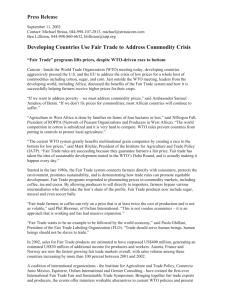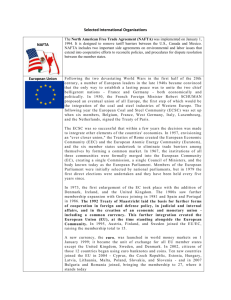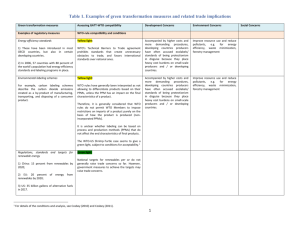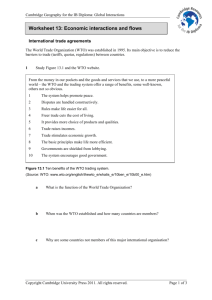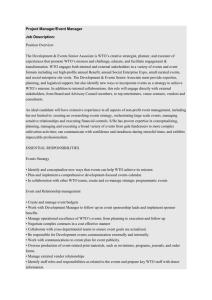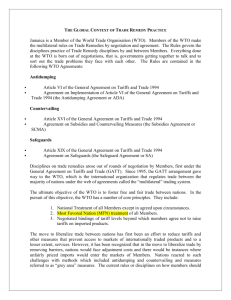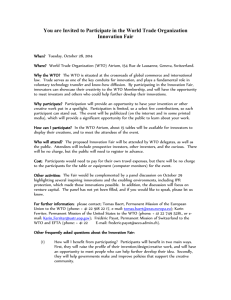International economic relations
advertisement
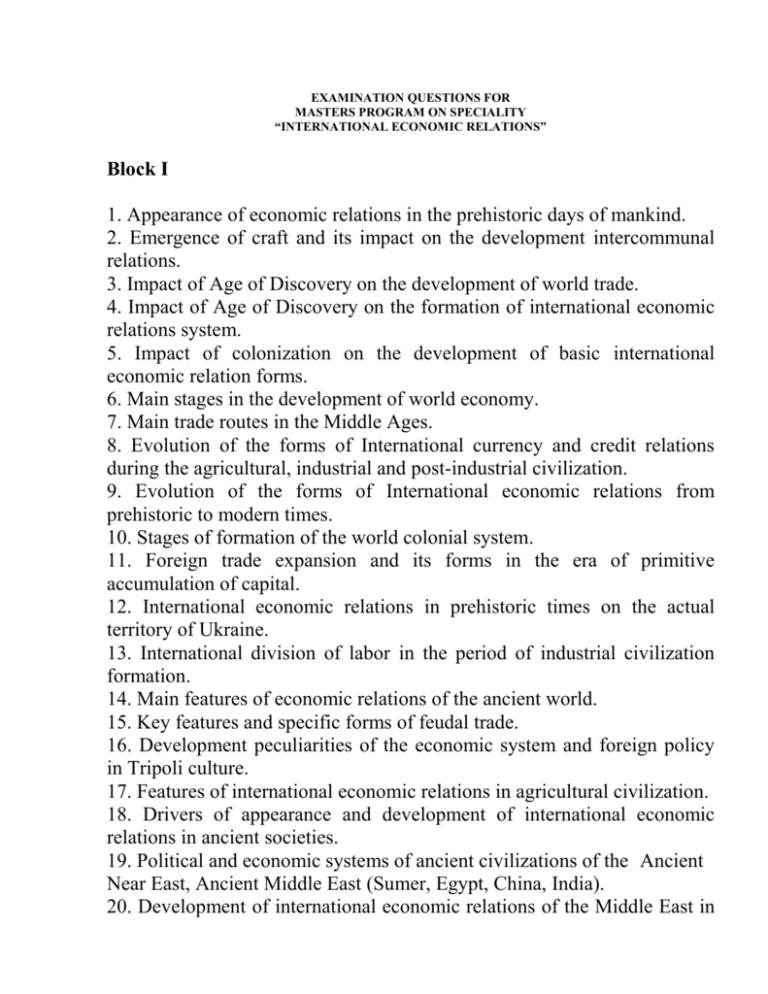
EXAMINATION QUESTIONS FOR MASTERS PROGRAM ON SPECIALITY “INTERNATIONAL ECONOMIC RELATIONS” Block I 1. Appearance of economic relations in the prehistoric days of mankind. 2. Emergence of craft and its impact on the development intercommunal relations. 3. Impact of Age of Discovery on the development of world trade. 4. Impact of Age of Discovery on the formation of international economic relations system. 5. Impact of colonization on the development of basic international economic relation forms. 6. Main stages in the development of world economy. 7. Main trade routes in the Middle Ages. 8. Evolution of the forms of International currency and credit relations during the agricultural, industrial and post-industrial civilization. 9. Evolution of the forms of International economic relations from prehistoric to modern times. 10. Stages of formation of the world colonial system. 11. Foreign trade expansion and its forms in the era of primitive accumulation of capital. 12. International economic relations in prehistoric times on the actual territory of Ukraine. 13. International division of labor in the period of industrial civilization formation. 14. Main features of economic relations of the ancient world. 15. Key features and specific forms of feudal trade. 16. Development peculiarities of the economic system and foreign policy in Tripoli culture. 17. Features of international economic relations in agricultural civilization. 18. Drivers of appearance and development of international economic relations in ancient societies. 19. Political and economic systems of ancient civilizations of the Ancient Near East, Ancient Middle East (Sumer, Egypt, China, India). 20. Development of international economic relations of the Middle East in the Middle Ages. 21. Development of international trade as the main form of international economic relations’ development in the Middle Ages. 22. Development of cities as centers of crafts and trade. 23. Scope and features of economic relations of the Ancient World. 24. Formational and civilization approaches to the study of international economic relations history. 25. Nature and forms of foreign economic relations of Kievan Rus. 26. Characteristics of foreign economic relations of the East countries in the Middle Ages. 27. Characteristics of the first international trade organizations and unions. 28. Characteristic features of foreign economic relations of medieval Europe. 29. Fair as a typical form of medieval trade. Block II 1. Bretton Woods system: principles, mechanism of operation. 2. World financial crisis influence on international capital flows. 3. World financial crisis influence on international trade in goods and services. 4. Hypothesis of “imitation lag” by M. Posner. 5. Main forms of capital export in the system of international economic relations. 6. Dynamics and structure of foreign trade in industrialized countries at the beginning of the XXI century. 7. Economy of China in the global division of labor. 8. Economic-mathematical models of international economic relations and world economy. 9. Economic effects of foreign direct investment. 10. Stages of Western European integration. 11. The EU in the global economy. 12. International economic strategy of the USA. 13. Integration processes in North America (NAFTA). 14. Intellectual property in the world economy. 15. Classical theory of international trade. 16. The Overlapping Demand Theory by Linder. 17. International Bank for Reconstruction and Development: structure and functions, credit mechanism. 18. International e-commerce. 19. International specialization and cooperation: types and forms. 20. International Trade. Product life-cycle theory. 21. International trade. Economies of scale 22. International trade. General equilibrium theory. 23. International trade. Monopolistic competition model by Krugman. 24. International trade. Neoclassical theory. 25. International trade. Leontief paradox. 26. International trade. Stolper–Samuelson theorem. 27. International trade. Absolute advantage theory. 28. International trade. Intra-industry trade theory. 29. International trade. The specific-factors model. 30. International trade: supply of factors of production. Heckscher–Ohlin theorem. 31. International division of labor: types and forms. 32. International loan capital market: main features and peculiarities. 33. International credit relations: main forms. 34. International financial markets: general characteristics. 35. Product life-cycle theory by Vernon. 36. Transfer pricing model by Herst. 37. Basic exchange rate theories. 38. Main types of foreign exchange systems. 39. Features of the integration process in Mercosur. 40. Features of the integration process in Southeast Asia. 41. Features of the integration process in Africa. 42. World services market, the dynamics and trends at the beginning of the XXI century. 43. World labor market and international labor migration. 44. Standard effects of international labor migration. 45. Scope and mechanism of solution of global problems of international economic relations. 46. Essence, views and role of international corporations on the global capital market. 47. Scope, purpose and types of international economic integration. 48. Trends in the modern world trade. 49. Rybczynsky theorem 50. Theories of the impact of technological progress on world trade. 51. Theories of international labor migration. 52. Theories of foreign direct investment. Dunning's eclectic paradigm. 53. Viner's theory of Customs Unions. 54. Ricardo's theory of comparative advantage in international trade. 55. Ukraine's role in the international movement of capital. 56. Forms of capital export. Enterprises with foreign investment. 57. Forms of international license trade. 58. Jamaica's monetary system: nature and structure. Block III 1. Monetary and financial methods of trade policy. 2. Types of subsidies and their role in foreign trade. 3. Free economic zones: the place and role in the global economy. 4. Influence of the customs tariff on producers, consumers and the economy as a whole. 5. Voluntary export restrictions in world trade. 6. World Trade Report 2011 7. GATT/WTO Doha round of negotiations. 8. Economic effects of tariff in a large economy. 9. Economic effects of tariff in a small economy. 10. Economic mechanism of dumping in foreign markets. 11. Economic effects of quantitative restrictions in foreign trade. 12. Economic effects of subsidies. 13. Effective tariff rate. 14. FTA EU - Ukraine: problems and prospects. 15. Tools of exchange control in foreign trade. 16. Intellectual property in international trade: concepts, forms and regulations. 17. Cartel regulation in international markets. 18. Quotas and quoting in world trade. 19. Quantitative restrictions in foreign trade. 20. Code of the WTO Customs Valuation. 21. Competitiveness of national economies. 22. CIS countries in the international integration processes. 23. International technology transfer. 24. Regulation mechanisms of international capital movements. 25. Regulation mechanisms of international labor migration. 26. International Finance Corporation: structure, functions. 27. International Monetary Fund: functions, mechanism of activity, main programs. 28. International currency markets: dynamics, structure, regulation. 29. International economic organizations and their role in modern international economic relations. 30. Neo-protectionism under the global financial crisis. 31. Restrictive business practices in global markets. 32. Optimal tariff rate. 33. Main ways of balance of payments regulation. 34. Main obligations of Ukraine's accession to the WTO. 35. Features of regulation of world commodities trade. 36. Balance of payments and exchange rate: the mechanism of the relationship and interaction. 37. Concept, form and functions of tariff. 38. WTO rules of the use of tax instruments. 39. The problems of pricing in international trade. 40. Regulation of public procurement under the WTO rules. 41. Regulation of international labor migration. 42. Regulation of international technology transfer. 43. Regulation of international trade in services. 44. Regulation of international trade in Cotonou agreements. 45. Regulation of subsidies and countervailing measures by WTO. 46. Development of Economic and Monetary Union in the European Union. 47. Role of organizations of the UN system in the regulation of international economic relations. 48. Role of UNCTAD in the regulation of international trade. 49. Global financial crisis 2008-2010: factors and mechanisms. 50. Special protective measures in foreign trade. 51. SDR as a form of world money: problems of functioning. 52. Standards and other special requirements for goods in international trade. 53.Structure of the mechanism of international commodity agreements functioning. 54. Structure of national systems of foreign trade regulation. 55. WTO agreement on anti-dumping measures. 56. WTO agreement on subsidies and countervailing measures. 57. WTO Agreement on rules of origin. 58. WTO Agreement on technical barriers. 59. WTO GATS, TRIPS, TRIMS Agreements. 60. Uruguay Round of negotiations within the GATT. 61. Fiscal policy and financial instruments of international economic relations regulation. 62. Forms and basis of dumping. 63. Forms of restrictive business practices at global markets.
